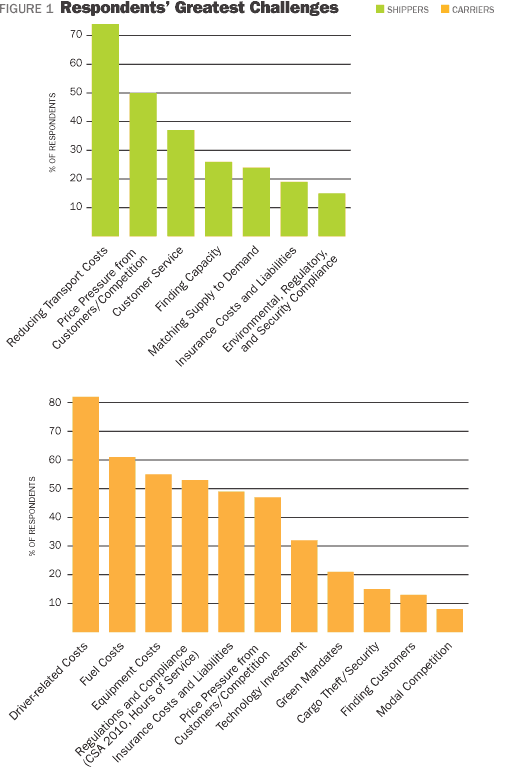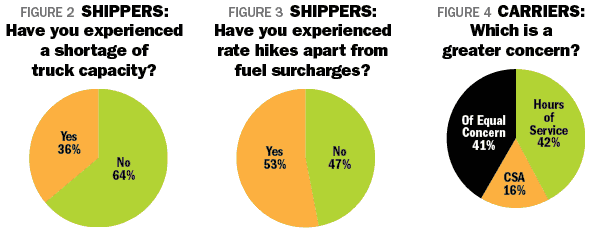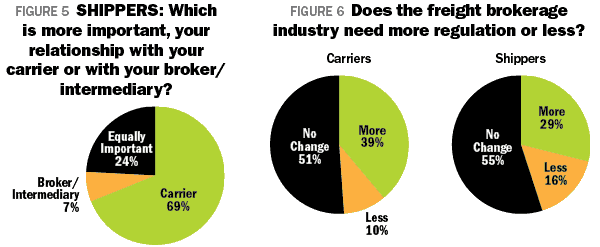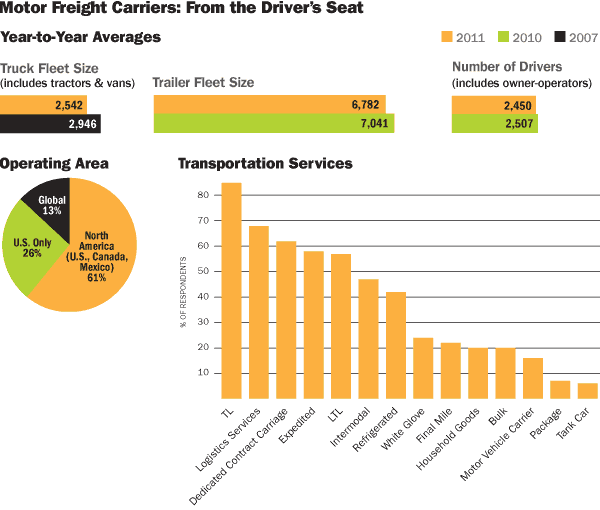Trucking Perspectives 2011: Exclusive Inbound Logistics Research

When the economy took its first plunge in late 2008, there was little doubt the motor freight industry would be collateral damage. Capacity was flush. Fleets had grown fat feeding on steady demand. Inefficiencies ran amok. The recession hit carriers hard and they paid a heavy price with bankruptcies, acquisitions, consolidations, layoffs, and stock insecurities filling the daily ledger.
Shippers were beset with their own recessionary problems in marketing and selling product to consumers without discretionary income. An abundance of capacity created leverage to chase cheap rates. It also created opportunities to strengthen bonds with core carriers.
Beginning in late 2010, there were signs that truckers had weathered the storm and were beginning to gain traction again. Many streamlined their fleets to be more efficient and to better match supply with demand. Others made proactive investments in technology and services to provide shippers with bundled value beyond commoditized transportation capabilities. “Partnership” became the token word as carriers cautioned promiscuous freight buyers that “what goes around comes around.”
Now, as the economy teeters on the edge of a double-dip recession, the trucking industry is primed and poised, if unsettled. On the one hand, over-the-road shippers responding to Inbound Logistics‘ 2011 Trucking Perspectives market insight survey are wary about rising fuel surcharges, freight rates, and the looming specter of widespread capacity shortages. Carriers, by comparison, share lessons learned from three years of uncertainty and hardship, concerns about emerging potholes on the road to recovery, and optimism about where the industry is headed.
Return on Assets
The recession has had an obvious impact on the trucking industry in terms of equipment. Many motor freight carriers purposely jettisoned older assets to recoup costs while bringing capacity back to equilibrium with demand.
Carriers report an average truck fleet size (including tractors and vans) of 2,542 units in 2011. Five years ago that mean was 2,946, a 12.7-percent decrease over that period, according to Inbound Logistics data.
The drop in trucks has been widely reported as motor freight carriers’ transition to newer, greener fleets that meet EPA regulatory requirements, while at the same time scaling assets to better reflect demand.
Truckload capacity is also measured in terms of trailers. In 2011, the average trailer fleet size is 6,782 trailers, according to carrier respondents. Last year (when IL first began recording this data), trucking companies averaged 7,041 units, a 3.8-percent decrease in year-to-year data.
For shippers, capacity remains a relatively suppressed problem softened by continuing economic lethargy and flat consumer spending. When asked to list the most important challenges they face, 26 percent of shippers cite capacity—well down the list of priorities (see Figure 1). More specifically, only 36 percent of respondents experienced a capacity shortage during the past year, according to IL Trucking Perspectives research (see Figure 2).
That said, when an economic rebound appeared likely in early 2011, space tightened in some lanes and carriers were quick to capitalize on increasing competition among customers. More than half of shipper respondents indicate they experienced rate hikes from carriers beyond fuel surcharges during the past year (see Figure 3).
For shippers, managing transportation spend is a cardinal priority. Seventy-four percent of respondents identify reducing transport cost as their top challenge, followed by price pressure from customers/competition (50 percent), and customer service (37 percent). Environmental, regulatory, and security compliance ranks last in priority, with only 15 percent of shippers identifying this as an issue. Many freight buyers are relying on carriers, brokers, and third-party intermediaries to help them mitigate these outlying concerns.
By comparison, a trio of cost-related issues dominates carrier concerns. Driver-related costs (82 percent), fuel costs (61 percent), and rising equipment costs (55 percent) are top priorities among motor freight companies (see Figure 1). Fuel spend has been partly mitigated by green initiatives, which many carriers have already addressed. Eighty-seven percent of Trucking Perspectives’ respondents are EPA Smartway partners.
The bane of the trucking industry remains finding, training, and retaining drivers. The average number of truck drivers (including owner-operators) dropped from 2,507 in 2010 to 2,450 in 2011, according to carriers. That represents a 2.3-percent decrease year over year —and many in the industry expect the drop to continue.
Rules of the Road
Among other bubbling issues, regulations and compliance developments—notably the Federal Motor Carrier Safety Administration’s (FMCSA) Compliance, Safety, Accountability (CSA) program and possible Hours-of-Service (HOS) changes—are top of mind for the motor freight industry.
More than half of surveyed trucking companies identify regulations and compliance as a challenge, which is only trumped by cost-related items as a priority. There is clear apprehension, especially with the possibility of more restrictive HOS mandates, that carriers will have to find even more qualified drivers from a shrinking pool of candidates further constrained by CSA standards.
When asked what is a greater concern, 42 percent of carriers cite HOS, 16 percent CSA, and 41 percent identify both as equal worries (See Figure 4).
Trucking companies are well aware that safety is a paramount interest in the industry. But there is pervasive opinion that HOS changes will have a far worse impact on productivity, and that the sum effect will be devastating to carriers that are already operating on razor-thin margins.
“The new HOS proposal would be challenging to our business,” explains one carrier respondent. “Since we primarily work in the food industry, operations are very time-sensitive and safety-oriented. The current 34-hour reset is a perfect tool for my fleet and how we run it. Changing that rule would require us to significantly adapt our operations and possibly drive up freight costs for consumers.”
FMCSA’s HOS proposal favors cutting daily driving time from 11 hours to 10, and would also restrict drivers’ ability to reset their weekly work cycle with a 34-hour rest break.
These changes would likely increase costs and decrease the productivity of transportation networks with yet-to-be-qualified safety benefits.
“If we lose another hour, the industry will become 10 to 15 percent less efficient,” says another carrier. “We already have a labor shortage under today’s regulations and I expect drivers will seek wage increases to compensate for reduced earning opportunities with the proposed new rules.
“Under the current rules, the motor freight industry has reduced the number of crashes three years running, and currently has the lowest accident rate in a decade,” the source continues.
Most distribution operations are not set up for clean, drop-and-hook deliveries, so idling drivers on the clock is a necessary evil. Carriers expect HOS rule changes will have a marked impact on cost structures and equipment availability. No less important, because capacity is expected to tighten considerably when the economy recovers, changes to driver operating procedures will reduce the pool of qualified owner-operators.
Carrier respondents are less concerned about the current CSA rollout because many already have employment-hiring practices that nest seamlessly with the FMCSA’s score-carding process. Still, some lament the lack of transparency and communication.
“It is a complex regulation, and appears to be launched with incomplete information,” says one carrier respondent. “The buying public doesn’t understand the terms and ratings.”
While potential changes to HOS rules impact truck runs, CSA directly targets employment. And shippers are already beginning to use CSA as a determining factor in carrier selection—directly and indirectly.
Brokering Change
The importance of the brokerage industry has been manifest over the past few years, helping shippers access capacity and compare rates, and carriers find loads and fill backhauls. As the economy showed signs of recovery in early 2011, and capacity rumors began circulating anew, motor freight buyers began shoring up core carrier partners and eyeing freight brokers to find hidden space.
Those reservations have been somewhat muted by the current economic relapse. But the shipping community is well aware of what looms beyond the bend. Sixty-nine percent of polled freight buyers value their relationship with carriers (compared to 57 percent in 2010), while seven percent favor brokers (two percent in 2010), and 24 percent (41 percent in 2010) view both as equally important (see Figure 5). There has been a noticeable and expected shift as motor freight shippers look to secure carrier relationships and lock up capacity.
Shippers have their own unique strategies for mixing and matching capacity. For example, a company might use asset-based carriers for less-than-truckload moves and leverage brokers for truckload, where there is more competition. Some like the fact that brokers have control over many truckers and cater to specific requirements and preferences. As one shipper notes, “I will hold the 3PL/broker accountable for any and all issues.”
Others prefer cutting out the middleman entirely and dealing directly with asset-based carriers. Shippers may prioritize oversight regarding equipment rates and reliability, and the safety records of carriers they are using. After all, as one shipper says, “the carrier is an extension of our business and represents us to our customers.”
Regulation on the Road
But moving forward, most shippers will have to tap 3PLs and intermediaries to find extra space. Consequently, a dearth of capacity and new CSA requirements will increase focus on the brokerage community, which has been largely lawless compared to other areas in the supply chain.
The majority of shippers (55 percent) and carriers (51 percent) believe the brokerage industry does not need any change in regulatory control (see Figure 6). Still, 39 percent of carriers and 29 percent of shippers think there should be more oversight.
By and large, the motor freight industry doesn’t want any more regulation, believing that it only hampers productivity. CSA, to a degree, will self-regulate brokers and carriers that run marginal equipment or skirt appropriate hiring practices. Ultimately, it’s up to the freight buyer to ensure service providers can fully uphold their responsibilities and functions.
“It’s becoming increasingly difficult to sustain quality in an industry that has already been hit extremely hard by the recession,” shares one shipper. “It will never build back up to the capacity it needs to be with more regulations.”
But there is a vocal minority that contends the freight brokerage space is too easy to enter, bond requirements are too low, and pricing structures fluctuate too much. As a result, brokers are deteriorating carriers’ bottom lines and making it more difficult for shippers to bargain with carriers.
There are also liability concerns, especially as double-brokering incidents continue to rise and freight claims’ accountability remains muddled. Nearly half of surveyed carriers identify insurance costs and liabilities as a current challenge. Most in the industry agree that brokerage rules could be better defined, and in some cases enforced, to ensure that a few bad apples don’t compromise the whole bushel.
One way or the other, increasing regulatory oversight will force shippers to be more accountable for the partners they choose, whether it’s through a broker or directly with a carrier.
The motor freight industry is poised to return to a position of strength after struggling through a period of extended adversity. Even with recent economic uncertainty, carriers are more flexible and responsive to market conditions, and the pendulum is swinging toward supply again as shippers begin losing pricing leverage.
Making the Switch
In 2011, only 42 percent of shippers report switching carriers recently, compared to 47 percent last year, and 44 percent in 2009. Smart motor freight buyers are reinforcing core carrier partnerships and contracting dedicated fleets where necessary in anticipation of a market rebound.
Pricing and reliability are neck-in-neck as far as shipper priorities when selecting carriers, with 88 and 87 percent of those polled responding accordingly. Customer service ranks third (64 percent). Capacity remains a peripheral concern, with only 38 percent of shippers considering that a factor in the decision-making process.
Meanwhile, the green revolution appears to be revolting, as only 29 percent of motor freight buyers base carrier selection on sustainability accomplishments.
There are clear signs that competition within the industry is beginning to heat up again after a few years of relative stasis. The current economic reversal may prove to be a stumbling block to recovery, or it may allow capacity to rebuild in a more gradual fashion—which would be a silver lining in cloudy economic forecasts.
Either way, compared to three years ago, motor freight carriers are in a far better position to react to change.
Motor Freight Carriers: From the Driver’s Seat
The economic depression of the last three years has had a marked impact on motor freight industry demographics, altering how carriers approach the market and partner with shippers.
While industry continues to look down an uncertain road, it does so from a position of strength. Efforts to scale assets, invest in technology, and become greener and more fuel-efficient have made carriers much more resilient and adaptable. Talk of tightening capacity earlier in 2011 allowed some to raise rates and begin playing their upper hand with shippers, who are now feeling the brunt of market equilibrium and still-soaring fuel and transportation-related costs.
Some trucking companies have taken U.S. economic sluggishness as a cue to explore growth opportunities offshore. Others are keeping their eyes on NAFTA trade volumes between Canada and Mexico, especially since the Mexico-U.S. cross-border trucking impasse has been resolved and Mexico has begun the process of lifting tariffs on U.S. imports.
In terms of services, motor freight carriers are segregated by commodity type and niche industry specialization. Truckload remains the staple, while pending capacity shortages leave shippers and carriers exploring and investing in intermodal connections, and locking up assets with dedicated contract carrier arrangements.
Trucking Perspectives Methodology
Inbound Logistics’ annual Trucking Perspectives market insight report includes input from both motor freight carriers and shippers to provide a comparative analysis supported by empirical data and anecdotal observations. Our outreach effort comprises two parts.
First, IL solicited more than 200 trucking companies to complete a questionnaire that documents their assets, service capabilities, operational scope, and areas of expertise. We also asked carriers to comment on challenges and opportunities in today’s market.
Secondly, Inbound Logistics reached out to more than 500 unique motor freight shippers to comment on industry trends, regulatory challenges, and their partnerships with carriers.




